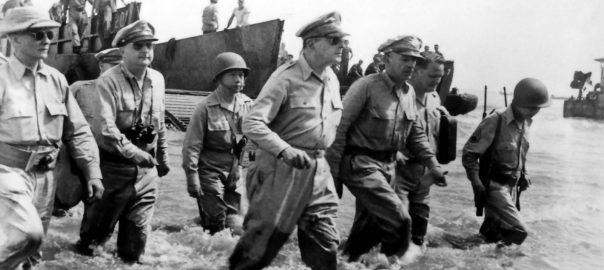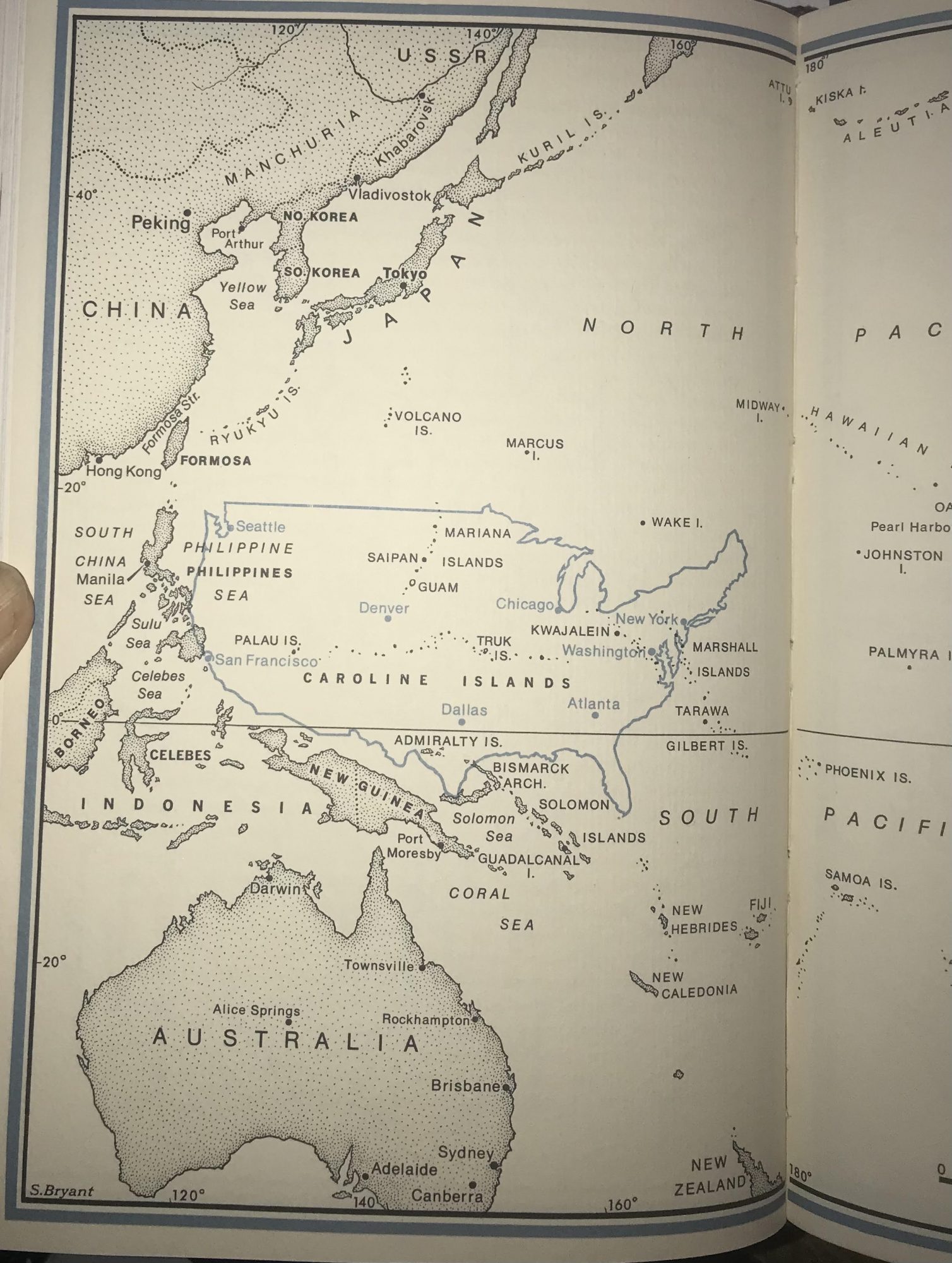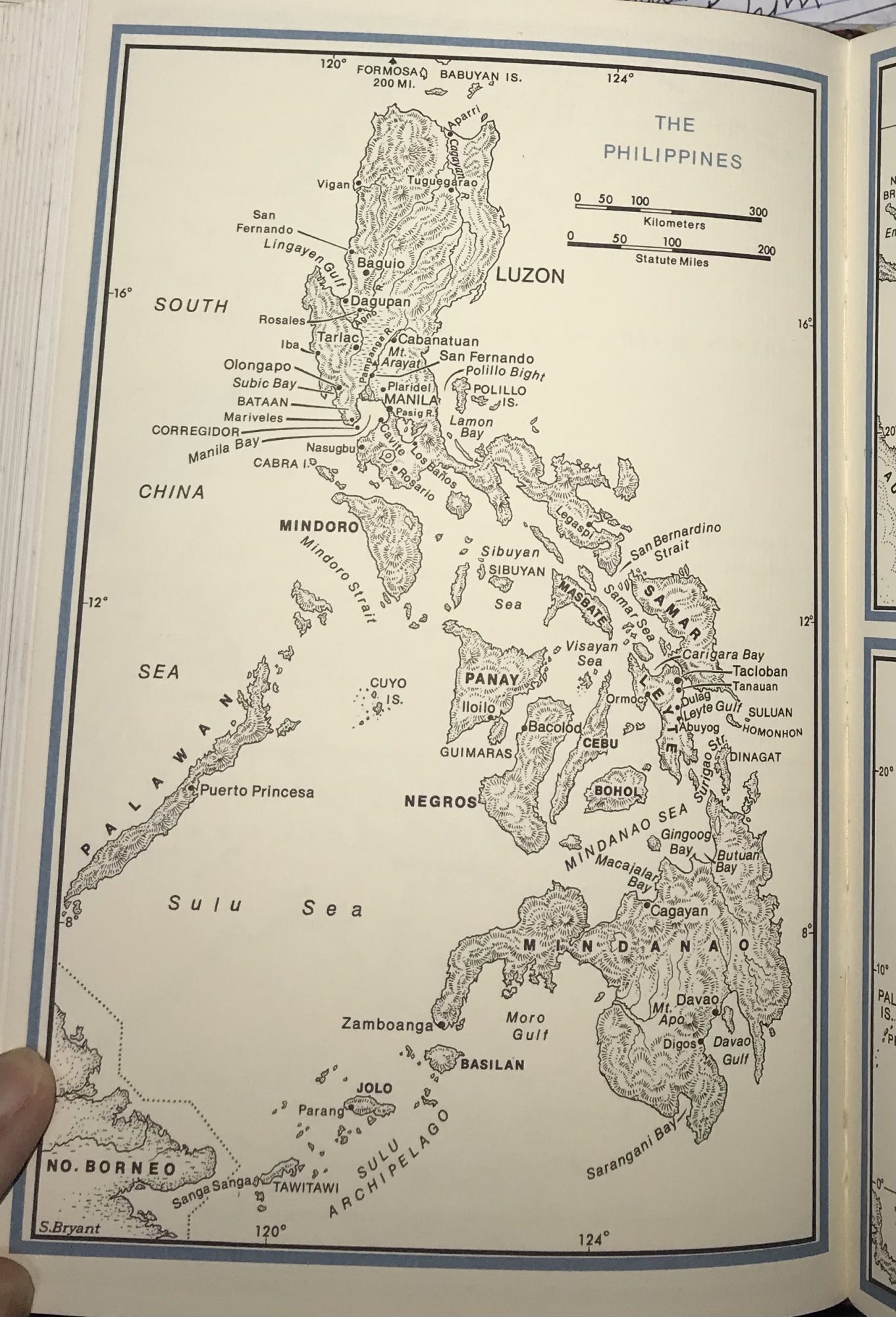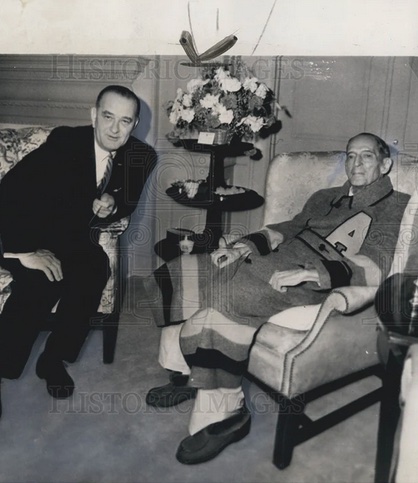I’ve been re-thinking how to proceed with my Project 500 Years. (Actually, as of now, Project 607 years, but who’s counting?) I have a number of ideas of new approaches I might use. But since I’m currently a little fixated on how the era of Western hegemony of the world order is currently ending, I thought I need to learn quite a bit more about the American reach across to the Pacific’s Western rim. (This is also important to understanding how the United States had become a truly global– two oceans– power, rather than just an Atlantic power.)
As it happened, when I was in Maine recently, I was able to pick up and read William Manchester’s 700-page biography of Douglas MacArthur, American Caesar: Douglas MacArthur, 1880-1964, and I learned a lot from it. Here were some of my main learnings:
MacArthur’s early life showed the extent to which America’s reach across the Pacific was simply a (maritime) continuation of the Anglo settler-colonial project in Turtle Island.
The guy was born in 1880, on a U.S. Army post in the American Midwest. His father was a high-ranking Army officer whose main task had been, since the end of the Civil War, to “pacify” (subdue) the Native Americans. In 1898, when the U.S. entered a global war against the dying Spanish Empire, the dad and all other U.S. Army officers were– in Manchester’s telling– delighted to finally have a “real” war to fight. The U.S. forces speedily seized several valuable properties from the Spanish, including the Philippines, Cuba, Puerto Rico, Guam etc. The dad MacArthur ended up as Governor of the Philippines.
Douglas meanwhile had been prodded by his super-ambitious mother (who’d been born to a proudly pro-Confederate Southern family) to go to the military academy at West Point. She even accompanied him there, staying in a hotel just off-campus, to make sure he wasn’t slacking off. After graduation, he scored a posting as aide-de-campe to his dad, in Manila.
I got a strong idea of the importance of the Philippines to the U.S. project on the Western Pacific rim.
The eastern coast of the northern bulge of the Eurasian landmass is marked by numerous strings of islands running roughly parallel to the mainland: Borneo, Philippines, Taiwan/Formosa, Ryukus, Japan, etc. Commanding those Philippines had given Spain a strong position in that area; and now it did the same for the United States.
U.S. forces had been in the neighborhood for a good long while already. Cmdr. Matthew Perry and the U.S. Navy’s East India Squadron had “opened” Japan to U.S. trade in 1854, inaugurating a whole new period in the history of still-independent Japan. But the U.S. presence in Philippines was different. It involved full-blown imperial/colonial control, with U.S. military and business interested simply taking over from the Spanish there.
All the long-existing European empires other than the Spanish kept the outposts and possessions they had long had along those archipelagos– the Portuguese, British, Dutch, and French. The French also had their imperial holdings on the mainland, in Indochina; and all those European powers and the United States had made several deep inroads (trade, missionaries, etc) into China. Now having acquired the Philippines, the United States was in the big leagues among the “western” powers in East Asia.
Douglas MacArthur was certainly a gifted military strategist.
William Manchester himself had fought as a Marine in the Pacific in World War II and seems to have had a fairly strong appreciation of military strategy. As for MacArthur, after the Japanese attack on Pearl Harbor in December 1941 brought the United States into the War, he was appointed Supreme Allied Commander for the South-West Pacific. His naval counterpart for the rest of the Pacific was Adm. Chester Nimitz. During World War I, MacArthur had fought in France, and had seen how the U.S. and Allied forces used amphibious operations there. In World War II, especially along the islands and land-masses that rimmed the Western Pacific, the challenge was, in Churchill’s felicitous phrase, to be able to plan and execute triphibious operations, which would see the new air forces well integrated into the planning for the land and maritime forces.
MacArthur’s first experiences of World War II were very challenging. He was in the Philippines (as the “Field Marshal” of the Philippine Republic, a U.S. protectorate.) In early 1942, he Japanese speedily came down and occupied Luzon. MacArhur withdrew his Filippino and U.S. forces to the Bataan Peninsula, west of Manila, and withdrew his military/political leadership to the rocky island of Corregidor and later from there to Australia. (The forces left on Bataan were captured by the Japanese and were forced into the “Bataan Death March.) Once in Australia, he started planning to retake the islands and archipelagos, jumping with great difficulty over the three years that followed to and along New Guinea, to the Philippines, to the Ryukus, and thence to Japan itself. (While Nimitz’s forces were also doing their island-hopping over via Kwajalein, Guam, etc.)
In one of the earlier high-level confabs that Pres. Roosevelt, PM Churchill, and Stalin had during the war, the three leaders agreed to prioritize the European theater over the Asian theater. So Nimitz and MacArthur had to make do with relatively few resources while that happened. The Japanese had over-run nearly all the East-Asian positions of the West European allies; via Burma, they came to the gates of British India, and in the South-West Pacific they were bombing some parts of northern Australia. But the Australians were able to hold firm and acted as a vital rear base for MacArthur when he started leapfrogging his way back along New Guinea and other islands to the Philippines. Manchester has several good section in which he describes how MacArthur would spend a lot of time gaming out possible moves as if in a game of chess against his Japanese counterparts, and would then choose an action that he thought they would find completely surprising…
MacArthur was a smart and constructive head of the U.S. occupation in post-war Japan, then a big hawk in Korea.
I guess I had known a little about these two aspects of his career, but Manchester spells them out pretty well.
MacArthur was named the Allied Military Commander of Japan right before the Japanese surrender. (It was he who accepted the surrender from the Japanese forces on August 15, 1945, just days after the Americans’ use of the world’s first nuclear weapons against Hiroshima and Nagasaki.) The order that named him commander of Japan also named him over-all commander of South Korea, but he supervised another U.S. general whose job it was to stand up the new government of South Korea.
The whole of Korea had previously been occupied and ruled by Japan since 1910, and throughout WW-II. But at the 1945 Potsdam conference, Pres. Truman agreed with Stalin that after the defeat of Japan the Soviet Union could rule North Korea down to the 38th parallel while the U.S. would rule Korea south of that line. That arrangement paid little or no heed to the desires of the Korean people, who had long had strong alliances with Communist resisters to the Japanese. In 1948, a socialist uprising erupted in South Korea. Then in 1949, the Chinese Communists’ People’s Liberation Army (PLA) continued its long campaign to seize power in all of China by routing the American-backed Kuomintang from the mainland. The KMT fled to Taiwan, and the PLA’s large, battle-tested forces were then much freer to come to the aid of their co-believers in Korea…
But actually, North Korean communist leader Kim Il Sung was much more closely tied to the Soviets than to the Chinese. In 1949, too, the Soviet Union conducted its first (very successful) test of a nuclear weapon.
In 1950, the Communist-backed insurgency in South Korea erupted anew and this time with the help of the North Korean forces it over-ran nearly the whole peninsula, except a tiny enclave in the southeast, near to Japan. Pres. Truman called on MacArthur, as the Supreme Allied Commander of the Far East region, to organize the counter-attack. In June 1950, the Americans were able to have the international force that Washington rushed over to MacArthur to achieve this designated as a U.N. force. (The Soviet Union was boycotting the U.N. Security Council because of its refusal to give China’s permanent seat to Beijing.)
During the Fall months of 1950, MacArthur was able to make impressive gains, that took the U.N. forces far north of the 38th parallel and right up to (North) Korea’s lengthy border with China. But then the Communist forces were able to regroup and return to, essentially, the 38th parallel:

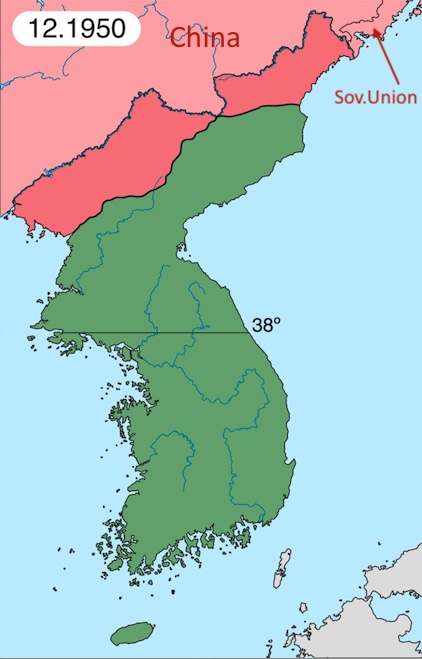
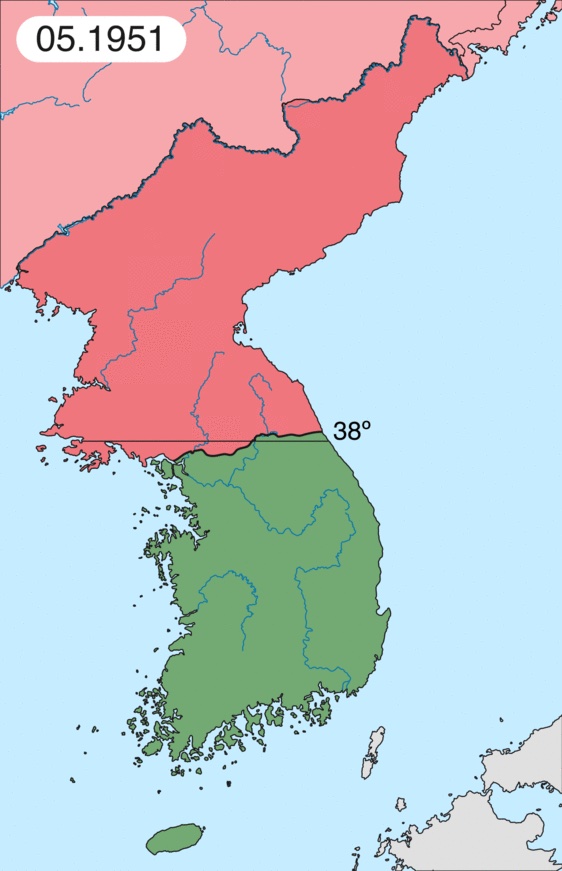
Green = U.S. & allies. Dark pink = North Koreans & allies. Light pink = China & USSR. Source.
Along the way, MacArthur had shown that he wanted to act in a way that was far tougher than his political masters back home in Washington were ready to do. (Significantly, he himself had not been back to the Continental United States since the late 1930s.) In August 1950 he sent a pugnacious letter to the VFW organization calling for unleashing the KMT fighters from Taiwan to fight against against the PLA. That letter had to be “withdrawn” after the Pentagon and White House got wind of it.
In late December, the North Koreans had already started pushing back southward, with help from the Chinese. Pres. Truman and his advisors decided to ask MacArthur what course of action he would recommend. His recommendation was this:
(1) blocade… the coast of China; (2) destroy through naval gunfire and air bombardment China’s industrial capacity to wage war; (3) secure appropriate reinforcements from the Nationalist garrison on Formosa [Taiwan] to strengthen our position in Korea… and (4) release existing restrictions upon the Formosa garrison for diversionary action…
quoted in ‘am. caesar’, pp. 621-22.
Truman and his advisors were horrified with the proposal and worked to find a way to reject it while also being aware that for many Americans MacArthur was still a deeply admired war hero. In early April 1951, MacArthur sent a letter to the Republican Leader of the House of Representatives that was deeply critical of Truman’s cautious policy, ending with these words: “if we lose the war to communism in Asia the fall of Europe is inevitable, win it and Europe most probably would avoid war and yet preserve freedom. As you pointed out, we must win. There is no substitute for victory.” The Republican read the text of the letter out on the floor of the House.
Finally, MacArthur had gone too far, and Truman decided he had to recall him, and the order to do so went out a few days later.
In his post-recall retirement, MacArthur switched from being a strong hawk to being a pacifist.
I found this the most intriguing part of MacArthur’s story.
After coming back to the United States, he spent a few years on a very lucrative, pro-war speakers’ circuit, while he and his family lived in a large suite at the Waldorf Towers in New York City that was paid for by the rightwing media magnate Henry Luce.
1952 was an election year, and he put his hat in the ring to be a contender, on the Republican side. But the Republicans chose another lauded U.S. Army WW-II hero as their candidate, instead of him. It was Dwight Eisenhower, hero of the European theater. Eisenhower had worked under MacArthur in the Philippines in the mid-1930s, but after leaving that position the two had fallen out professionally. Now, MacArthur had to see his (noticeably younger) underling get the ultimate prize that a large part of him clearly craved.
American Caesar includes a great little vignette of how in December 1952, while Eisenhower was still President-elect, he invited MacArthur to meet with him in New York. At the meeting. MacArthur–
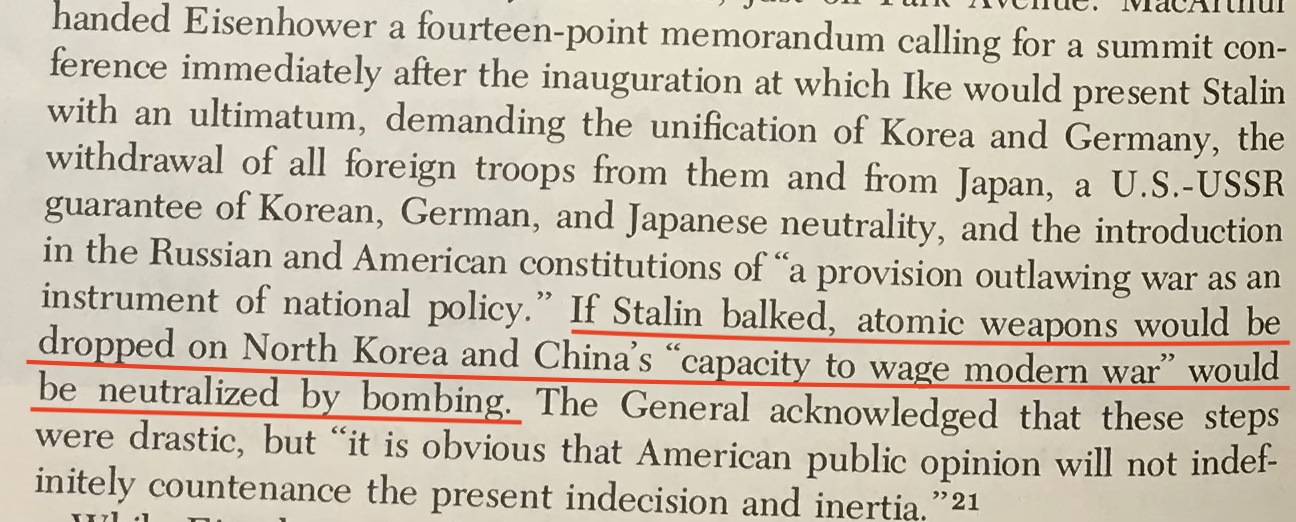
Eisenhower rejected that suggestion and had little or nothing more to do with the old general.
Over the next two years, however, MacArthur’s views changed. In January 1955 he gave a talk to an American Legion gathering in Los Angeles in which, after reviewing the changes that the nature of warfare had undergone since his days at West Point, he concluded that, “the very triumph of scientific annihilation [had] destroyed the possibility of war being a medium of practical settlement of international differences.”
In modern war, he said, “If you lose, you are annihilated. If you win, you stand only to lose.” (Am. Caesar, p.695.)
In 1960, John Kennedy was elected president. He had none of the bad-history baggage with MacArthur that both Truman and Eisenhower had had and was probably eager to be seen as conferring with the old war hero. Early in his presidency he flew to New York to meet him. Presidential historian Ted Sorenson wrote that in that meeting MacArthur, “warned [Kennedy] against the commitment of American soldiers on the Asian mainland, and the President never forgot that advice.” Crucially, Kennedy decided not to send U.S. troops from Okinawa to Vietnam.
After Kennedy’s assassination, MacArthur gave the same advice to his successor, Pres. Lyndon Johnson. Johnson notably did not follow it.
The crux of MacArthur’s turn to pacifism seems to have been the “absolutist”, all-or-nothing, way in which he had long conceived of his major campaigns. The turn that many key Pentagon war planners had made in the 1950s and 1960s toward searching for “flexible” ways to use nuclear weapons did not sit well with him. During his time as Military Governor of Japan he certainly had every opportunity to see the results of the all-out bombing campaigns the U.S. Air Force had visited on that country– both through the broad campaigns of firebombing in mid-1945 and through the use of the two atomic weapons in August that year.
It was also interesting that, in their somewhat different ways, both MacArthur and Eisenhower ended their lives convinced that the schemes of the war-makers needed to be reined in. Eisenhower’s post-presidential warnings against the increasdsingly entrenched power of the “military-industrial complex” are much the better known. But MacArthur’s warning that in a nuclear world, “If you lose, you are annihilated. If you win, you stand only to lose” certainly also deserves a lot of attention.
